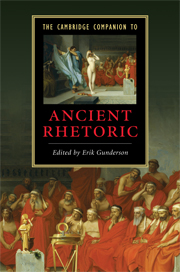Book contents
- Frontmatter
- Introduction
- Part 1 An archaeology of rhetoric
- Part II The field of language
- Part III The practice of rhetoric
- Part IV Epilogoues
- 14 Rhetorical practice and performance in early Christianity
- 15 Rediscoveries of classical rhetoric
- 16 The runaround: a volume retrospect on ancient rhetorics
- Appendix 1: Rhetorical terms
- Appendix 2: Authors and prominent individuals
- References
- Index of passages
- Index of subjects
- Series list
15 - Rediscoveries of classical rhetoric
from Part IV - Epilogoues
Published online by Cambridge University Press: 28 January 2010
- Frontmatter
- Introduction
- Part 1 An archaeology of rhetoric
- Part II The field of language
- Part III The practice of rhetoric
- Part IV Epilogoues
- 14 Rhetorical practice and performance in early Christianity
- 15 Rediscoveries of classical rhetoric
- 16 The runaround: a volume retrospect on ancient rhetorics
- Appendix 1: Rhetorical terms
- Appendix 2: Authors and prominent individuals
- References
- Index of passages
- Index of subjects
- Series list
Summary
The renaissance of classical rhetoric can be characterized in three words: recovery, addition, and change. First it was necessary to copy and circulate the texts (after 1460 by printing them). The order in which the texts were recovered and the traditions of teaching established around the earliest known texts constrained the ways in which rhetoric could be thought about. Then rhetorical doctrine had to be adapted to changed social circumstances both by the way in which selected classical texts were grouped into syllabi and interpreted, and through the composition, especially in northern Europe, of new rhetoric textbooks. For most medieval and renaissance teachers rhetoric was about writing rather than speaking and the three classical genres, with their built-in assumptions about audience and context, did not really suit the newly important occasions of letter-writing and preaching. Some of the ways in which renaissance authors developed classical rhetoric resemble the approaches and techniques of classical adapters, though sometimes extending the approach to the point where the product becomes rather different. Some of what looks mechanical in renaissance rhetoric will generate writing which is surprisingly playful and creative.
The rhetorical legacy of the ancient world has proved particularly imposing. In antiquity Quintilian’s Institutes selected and organized the ideas of Greek and earlier Roman rhetoricians as a sort of classic canon. Even today the fourth edition of Edward Cobbett’s successful university textbook Classical Rhetoric for the Modern Student assumes that the precepts of classical rhetoric (suitably selected, packaged, and adapted) can still teach the principles of good writing. The post-antique success of classical rhetoric is owed partly to the weight of what survives, partly to the perceived importance of instruction in the use of language (paired with the conceptual difficulty of making a new start on it), and partly to the circumstances in which learning and education were reborn.
- Type
- Chapter
- Information
- The Cambridge Companion to Ancient Rhetoric , pp. 261 - 277Publisher: Cambridge University PressPrint publication year: 2009

